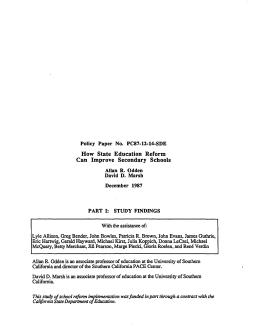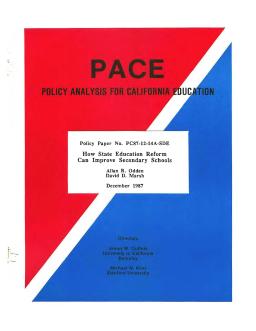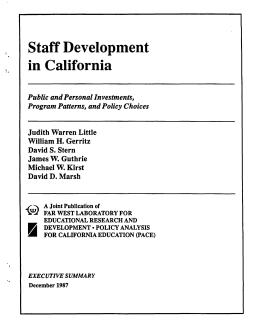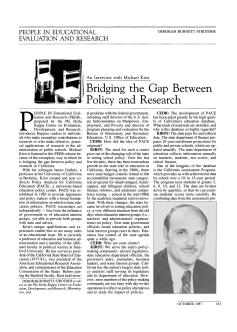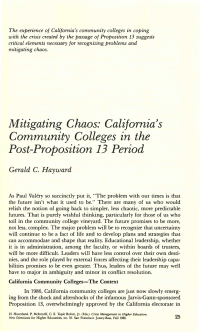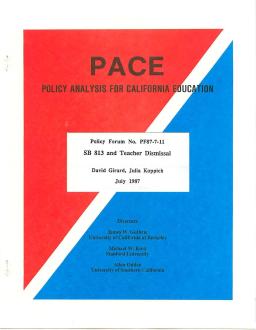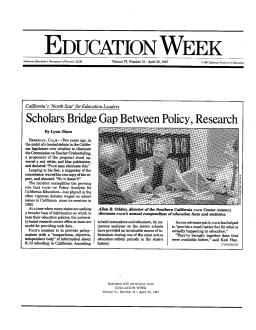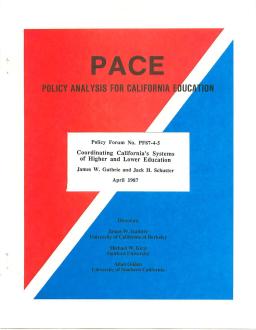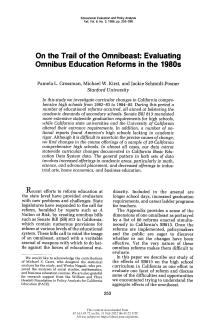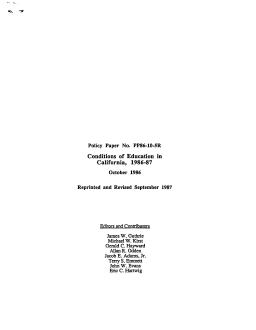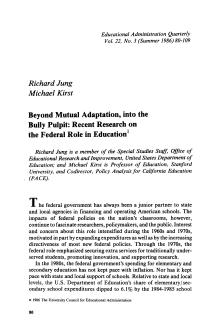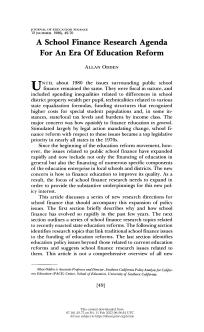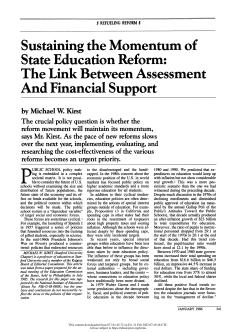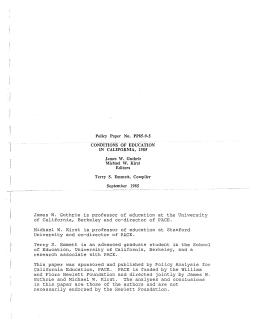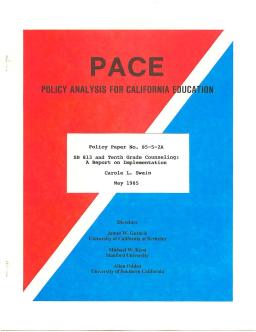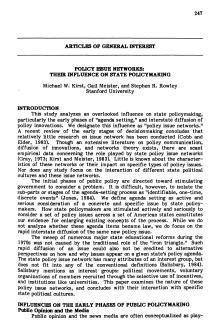Study Findings
Published
Summary
In 1983, California's Senate Bill 813 aimed to improve the education system by proposing a large number of reforms. However, it lacked a cohesive strategy and proven philosophy. The bill's impact on school districts and schools was unknown, and this study aimed to assess whether selected schools could implement the reform components and whether they contributed to school improvement. The goal was to understand how schools reacted to state mandates and inducements for improvement.
Background and Technical Appendices
Published
Summary
California's education system faced a decline in the early 1980s, prompting reforms such as a common core curriculum, higher graduation requirements, and tougher academic standards. A Nation at Risk report further pushed for nationwide school changes. California's swift response led to the enactment of Senate Bill 813, a comprehensive education reform program with over 80 policy and program reforms. Several studies showed positive results, but the study in this report aims to determine how state-level education reforms improved local schools.
Public and Personal Investments, Program Patterns, and Policy Choices—Executive Summary
Published
Summary
The California Staff Development Policy Study was initiated to assess the possibilities and limitations of staff development in improving classroom teaching and learning. The study aims to answer four questions related to California's investment in staff development, how staff development activities are administered, and how teachers and administrators judge their effectiveness. The study yields eight main conclusions, presented in terms of investment and focusing on improving the capacities and commitments of California's educators.
Bridging the Gap Between Policy and Research
Published
Summary
Michael Kirst, professor at Stanford University and former president of the California State Board of Education, is interviewed by People in Education Evaluation and Research (PEER). Kirst co-directs the Policy Analysis for California Education (PACE) project, an independent education policy center that provides unbiased research to legislators and policy makers. With Kirst's extensive experience in education and government, he is uniquely qualified to understand multiple sides of educational issues.
California's Community Colleges in the Post-Proposition 13 Period
Published
Summary
The passage of Proposition 13 in 1978 sent shockwaves through California's community colleges, affecting all aspects of their operations. The crisis exposed the colleges' lack of preparedness for such magnitude, leaving them grappling to cope with chaos. This article looks at California's experience and highlights critical elements necessary for recognizing problems and mitigating chaos. Educational leadership will need to be adept at ambiguity and conflict resolution as the future promises to be more complex and unpredictable. Finance, mission, and governance are the three key areas of focus.
Published
Summary
In 1985, the Policy Analysis for California Education (PACE) convened a group of attorneys and education policy experts to discuss the effect of Senate Bill 813 on teacher dismissal. They explored varying interpretations of its provisions, contrasted practical experiences with legislative intentions, and outlined recommendations to improve the dismissal process. This summary analysis includes a brief discussion of relevant court rulings and no attempt has been made to update the information since its initial publication.
Published
Summary
PACE, a university-based research center, provides "nonpartisan, objective, independent" information on K-12 schooling in CA. Its analyses have been invaluable to lawmakers and educators during the state's active education-reform period. PACE has played a growing role in debates on school issues, exemplified by a heated debate in the CA legislature over the Commission on Teacher Credentialing. PACE offers a model for providing data for education policies when many states are seeking broader information bases. It has helped provide a better understanding of what is happening in education.
Published
Summary
California's higher and lower education systems are inadequately coordinated, resulting in negative effects on teacher quality and disruptive changes in admission requirements. The low status of teacher training in universities and the irrelevance of education research to teaching needs exacerbate the problem. Four complex policy areas require consideration: teacher preparation, admission policies, education research, and statewide education coordination. To benefit students at all levels, effective planning and coordination are critically important, extending beyond voluntary efforts.
The Next Needed Education Reform
Published
Summary
Educational reform in the US has shifted from equal opportunities to greater school productivity. There are some positive results with increased enrolment in academic courses, rigorous textbooks, and raised admission standards for higher education. However, fundamental components of the reform are at odds with the dynamics of organizational revitalization. Without policies that unleash productive local initiatives, the reform is likely to lose momentum, eroding citizens' confidence in schools and generating public resources for them.
Evaluating Omnibus Education Reforms in the 1980s
Published
Summary
The study examines curricular changes in California's high schools from 1982 to 1985, a period of educational reforms aimed at increasing academic rigor. The state mandated more extensive graduation requirements while universities adjusted their entrance requirements. A sample of 20 comprehensive high schools shows increased academic offerings in math, science, and advanced placement, and decreased offerings in industrial arts, home economics, and business education, reflect statewide trends.
Published
Summary
Continuing growth and sustained progress on educational reform characterize California's public schools, but the Gann spending limit, which potentially restricts state dollars for education, and projected shortages of highly qualified teachers dampen prospects for continued educational improvements. Indications of important educational progress in California, which PACE documented in Conditions of Education in California, 1985, continue on many fronts. This is particularly true when compared to the recent decade of serious decline in California's public school system.
Recent Research on the Federal Role in Education
Published
Summary
This article reviews the literature on federal involvement in U.S. elementary and secondary education, from the 1960s to the present day. The federal government's share of spending has decreased since the 1980s, and regulatory pressures have subsided. However, this review identifies trends and themes that have emerged in the literature since the 1980s, encompassing both empirical research and normative commentaries. A literature review primarily focuses on work completed after the early 1980s research syntheses and excludes judicial policies.
Published
Summary
Before the 1970s, public school finance issues were mainly related to spending inequalities. However, since then, the focus has shifted towards financing education to improve its quality. This article suggests new research directions for school finance that address this policy interest, including topics related to state education reforms, traditional school finance issues, and education policy issues beyond current reforms.
The Link Between Assessment and Financial Support
Published
Summary
Public school policy making is embedded in a complex societal matrix. It is not possible to consider the future of U.S. schools without examining the size and distribution of future populations; the future state of the economy and its effect on funds available for the schools; and the political context within which decisions will be made. The public school system is a "dependent variable" of larger social and economic forces.
Published
Summary
Several state legislatures have acted on recommendations to improve U.S. public schools, resulting in a swift and broad education reform movement. States have expanded school improvement programs, increased high school graduation and college admission requirements, deepened course offerings, and strengthened the teaching profession. Indicators of progress include longer school attendance, tougher academic courses, better counseling, higher achievement test scores, and increased teacher pay. This swift and broad movement gives reason for optimism about its success.
Waivers and School-Based Program Coordination Under AB 777
Published
Summary
California's waiver authority provides school districts relief from Education Code, allowing them to seek alternatives to state requirements subject to local and state review. Waivers are automatically approved unless denied by the State Board of Education, which rarely happens over local objections. Program waivers are rare despite clamor for needed flexibility, possibly due to districts being unaware of the process, viewing it as time-consuming, or using suboptimal local procedures. Oversight hearings are recommended to explore the potential of the waiver process.
Published
Summary
This technical report provides an overview of California's educational system, intended for educators, public officials, journalists, and informed citizens. With over four million students and a $17 billion annual cost, the state's school system is vast and complex. The report offers comparisons of California's education system to itself in prior years and other states, revealing patterns of change and suggesting future trends. These trends serve as a guide for the many facts and figures presented in the report.
1982–83 to 1984–85
Published
Summary
This study examines curricular changes in California high schools from 1982-85, as educational reforms aimed to enhance academic rigor. Findings show increased offerings in academic subjects like math, science, and advanced placement, and decreased offerings in areas such as industrial arts, home economics, and business education. The data aligns with statewide curricular changes, likely influenced by mandates for more extensive graduation requirements and alterations to university entrance requirements.
A Report on Implementation
Published
Summary
Comprehensive school guidance programs attempt to address a range of student needs on personal, social, career, and academic dimensions. Many guidance and counseling programs, however, have suffered cutbacks in recent years even though students continue to be in need of guidance, and students themselves have expressed a desire for assistance.
Their Influence on State Policy Making
Published
Summary
This report analyzes the role of policy issue networks in early state policymaking stages and interstate diffusion of policy innovations. It defines agenda setting as active and serious consideration of a specific issue by state policymakers and investigates how state policymakers are stimulated to consider policy issues across the U.S. The authors further examine the nature of policy issue networks and their interaction with specific state political cultures, providing insights into the rapid interstate diffusion of new policy issues in the 1970s.
Published
Summary
This study examines consolidation's impact on student achievement in California. It finds that consolidation leads to improved educational opportunities and cost savings. Consolidation benefits low-income and minority students and has a greater impact in rural areas. Although drawbacks exist, consolidation can be an effective strategy for enhancing education. These findings offer valuable insights for policymakers and education leaders seeking to improve student outcomes in their districts.
Published
Summary
The first in a series of annual reports on education in California aims to assess school performance objectively. It summarizes data on demography, academic performance, curriculum, personnel, and finances. Highlighting California's 1983 education reform effort, the report provides a baseline for assessing future reforms, with successive reports addressing the same dimensions. It focuses on K-12 public schools but also includes some data on nonpublic and postsecondary education.
